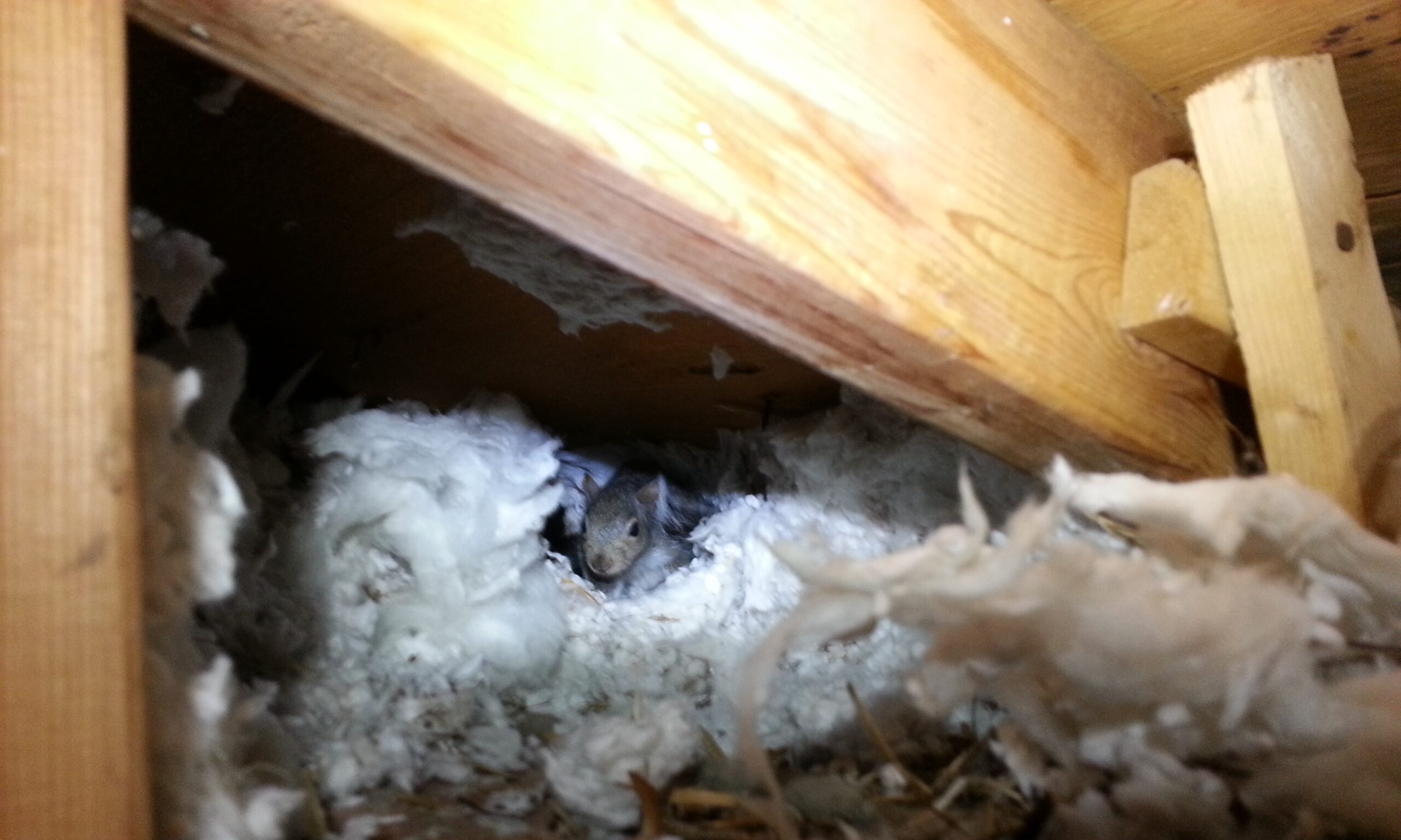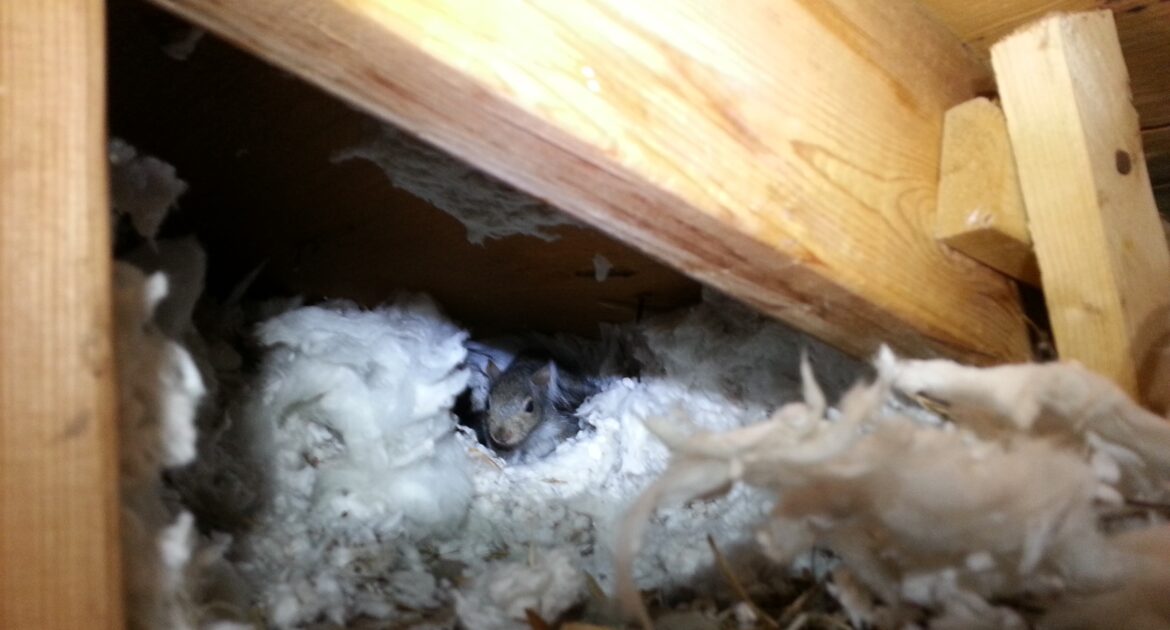When it comes to understanding where squirrels nest, the impact of their nest construction on your property is often underestimated. What do squirrel nests look like, and when do squirrels build nests? These seemingly simple questions hold significant importance for homeowners concerned about the structural integrity of their homes and the health hazards these animals pose.
At Skedaddle, we’ve seen firsthand how squirrel activity can cause problems ranging from insulation damage to fire risks. Understanding these risks and knowing how to respond is crucial for effectively protecting your home.
Where Do Squirrels Nest?
Squirrels are incredibly resourceful creatures, and their nesting habits highlight their adaptability. They typically build nests in two types of locations, depending on what suits their needs best—trees and human structures. Wildlife experts often refer to nests in trees as “dreys,” which are made by weaving together twigs, leaves, bark, and other natural materials to create a weatherproof structure. These nests are often located in high branches for safety and concealment from predators.
However, human structures, such as attics, chimneys, and walls, provide an all-season alternative for these animals. These spaces offer warmth and protection, especially during colder months. Attics, in particular, are highly attractive nesting spots because they’re quiet, warm, and provide an abundance of insulation material for them to use. While tree nests might capture a homeowner’s curiosity when glimpsed outdoors, it’s the nests inside homes that cause the most problems.
This kind of nesting behavior transforms not just your home but also your property, paving the way for costly issues. Insulation and wiring are common casualties. The materials that squirrels shred to build their cozy habitats include fiberglass insulation, cardboard, and even stored papers within homes. Wiring becomes a target because chewing helps keep their teeth from overgrowing. This damage poses not just structural risks but safety risks, including potential electrical fires.
What Do Their Nests Look Like?
Identifying what squirrel nests look like can help you spot them early and tackle an infestation before it becomes severe. Outdoor nests, or dreys, are usually rounded and can look like a messy ball of leaves wedged between tree branches. They are compact and densely packed with various materials, from twigs and leaves to moss and grass. If you notice several dreys near your property, it could be an indicator of high squirrel activity that might eventually spill into your home.
- Indoor nests often differ significantly from outdoor nests.
- In attics, nests may appear as disorganized piles of shredded insulation, wood chips, or other collected materials.
- Unlike neat outdoor dreys, indoor nests are messy.
- The messiness reflects the freedom squirrels have when living in human structures.
From a wildlife control perspective, spotting these nests requires close observation and, often, professional assessment. A home that emits rustling noises from the walls or roof is likely harboring one or more nests. You may even notice urine stains on your ceilings or walls, or spot wood shavings at baseboards where an animal has chewed through weak areas to gain entry. Recognizing these signs helps homeowners make informed decisions and avoid long-term property damage.
When Do Squirrels Build Nests?
Understanding the seasonal behaviors of squirrels gives homeowners an advantage in determining when preventative measures are particularly important. Squirrels generally build or repair their nests during late summer and early fall. These periods ensure they’re prepared for the colder months, during which their ability to freely collect materials may be limited.
Additionally, squirrels often construct secondary nests to prepare for future litters. Birthing seasons typically occur twice a year—in late winter and late summer—which are also the times you may see or hear increased activity as they prepare safe, secure spaces for their young.
During these seasons, home intrusions are more common. The pressing need for warmth and increased activity levels frequently bring them closer to human residences. These entry attempts can often go unnoticed until substantial damage has already occurred. This predictable behavior reveals why acting proactively is so important in addressing concerns about these animals becoming uninvited guests.
How Squirrel Nests Impact Your Property
Most people underestimate how significant the impact of a squirrel’s nest can be. The structural and aesthetic risks are only part of the problem. More critically, nests often create a perfect storm for health hazards and safety risks that homeowners may not consider until it’s too late.
The shredded materials used to construct nests heighten fire risks as exposed wires and overheated insulation become easy sources of ignition. Furthermore, nests themselves can block ventilation ducts or deteriorate roofing materials, leading to leaks and mold growth. An infrequent inspection may result in costly repairs that could have been avoided with timely intervention.
Health hazards are another serious concern. The presence of these animals often brings parasites such as fleas, ticks, and mites into a home, which pose risks to both human family members and pets. Additionally, their droppings can lead to unpleasant odors or the spread of diseases, such as leptospirosis. These are issues most homeowners only realize after prolonged exposure, underscoring how essential early detection is.
Lastly, these nests contribute to more widespread squirrel problems as their young mature and grow. Increased numbers can turn a single infestation into multiple nests within walls, chimneys, and even outdoor areas like garages. The longer the problem persists, the harder it becomes to manage without specialized interventions.
Skedaddle’s Wildlife Control Process
At Skedaddle, we’ve been perfecting humane wildlife control methods for years, helping homeowners protect their properties while safeguarding the animals involved. Unlike quick fixes that may inadvertently harm wildlife, we provide solutions designed to address the root problem comprehensively and responsibly.
Our process begins with a thorough inspection to identify entry points, nesting locations, and the extent of damage. Once nests are identified, our trained technicians use humane exclusion methods that allow the animals to leave without false promises of “one-size-fits-all” traps. Afterward, we secure your home to ensure no future entry is possible and offer cleaning and decontamination services to address sanitation concerns caused by waste.
With our expertise, you’re not only safeguarding the structural integrity of your property, but you’re also investing in a sustainable solution that prevents issues from recurring. Customized advice is always included to further protect your property and reduce risk, so you can rest easy knowing your home is safe from future intrusions.
Take the First Step to Protect Your Home
Understanding where squirrels nest and identifying their nests are critical first steps in avoiding potentially costly damage to your home. Recognizing the seasons and behaviors that lead these animals to build nests can make a big difference in making your property less inviting to wildlife.
If you’re noticing signs of nests within your home or property, don’t hesitate to reach out. At Skedaddle, we specialize in creating smart, humane solutions to wildlife challenges that keep your home secure. Get in touch today, and let us help you make sure your space stays yours, without added stress.




